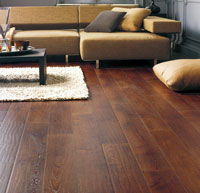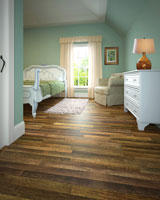HICKSVILLE, N.Y.—There may be signs of life in the economy, at least on the residential side, but the overall pace remains slow. Add to that a drastic drop  in wood prices—especially from imports—the continued surge in popularity of luxury vinyl tile (LVT) and an overcapacity problem, and the laminate category continues to struggle to regain the momentum it had just before the financial and housing crises hit.
in wood prices—especially from imports—the continued surge in popularity of luxury vinyl tile (LVT) and an overcapacity problem, and the laminate category continues to struggle to regain the momentum it had just before the financial and housing crises hit.
Research conducted by Floor Covering News to see how the category has fared over the first four months of 2010 compared to the same period last year has rendered mix results. On one hand, product is starting to move through the channel as more consumers break from their shells and once again begin to shop for home improvement items. On the other hand, dollar volumes and profits remain sluggish as the post-recession consumer searches for products that will give her the most performance at the lowest price.
As such, for the first third of the year sales in terms of units sold appear to have been ahead of last year’s same period by close to 10%, while actual dollars resulting from those sales were essentially flat.
The initial results for this year are “not bad,” as some officials put it when considering the category as a whole had been experiencing double digit drops in both dollars and units for all of 2009 and 2008 when compared to previous years.
With consumers cautiously opening their purse strings, a number of executives with whom FCNews surveyed said demand for higher end goods is starting to  slowly come back. As a result, most feel the disparity between units and dollars will not be as great by year’s end.
slowly come back. As a result, most feel the disparity between units and dollars will not be as great by year’s end.
Milton Goodwin, Armstrong’s vice president of laminate, noted, “There’s gravitation toward the lower end since people are being more careful with their money.”
George Kelley, president and CEO of Pergo, agreed consumers “remain cautious with their discretionary spending” and demand in value products increased in the first four months of 2010. But, we expect demand for our premium and branded products to continue to improve as consumer confidence grows and products up the value chain are sought.”
Roger Farabee, senior vice president of marketing for Mohawk’s Unilin division, maker of Quick•Step and Mohawk branded laminate, said it was only a matter of time before consumers re-entered stores seeking to make a purchase. “Americans like to shop, and there is a limit to how long she will stay out of the market. The only difference is consumers are not spending at their previous rates.” Kim Holm, president of Mannington Residential, called sales “bipolar,” noting upper end goods are starting to be bought alongside the so-called value products. But, there has been an erosion of price at the high- and mid-levels so, for example, a traditional 8- inch product is now thought of as entry level.
Travis Bass, vice president of sales and marketing for Kronotex USA, maker of the Formica brand, sees things from a unique perspective as the company is, in a sense, split between high and low. On the high end it has the Formica brand, while at the value end it markets under Kronotex, plus it has a healthy private label business. He noted the latter two have fared better of late “but the higher branded products are starting to get more activity in the last couple of months. And, in the value brands, we’re seeing consumers move up some—from 7mm to 8mm products.”
Costs, competition, capacity
While consumer confidence is coming back, executives say a confluence of events—from rising materials and energy costs to a worldwide overcapacity glut to increased competition from other flooring products— has created added pressure on the category.
“The categories that laminate had once taken market share from are biting back,” noted Russ Rogg, Wilsonart’s director of sales.
 Farabee added, “The history of laminate saw volume come from resilient, wood and a little from carpet. But in the last few years we’ve seen these take share back. Those looking at high-end laminate can now buy engineered wood for a similar price”
Farabee added, “The history of laminate saw volume come from resilient, wood and a little from carpet. But in the last few years we’ve seen these take share back. Those looking at high-end laminate can now buy engineered wood for a similar price”
Holm said it is not so much the resilient category as a whole taking back share, but the rise of LVT. “We always felt the laminate consumer is performance-minded, which is why they like the product. Now, LVT sports similar wearlayers and performance attributes, and the visuals are equal. But, with LVT, she gets softness, quiet and warmth. Wood is also a stronger challenger because there are so many low-end goods.”
Others echoed these sentiments, but added the biggest challenge is price. “Low demand and over capacity has put pressure on price despite the fact the cost of the product is going up,” explained Goodwin. “You have rising costs being laid up against over capacity so it is very challenging to make sure margins are being maintained.”
Bass added, despite costs across all materials reaching “unprecedented levels, we’re not comfortable passing them on due to lower foreign products coming in.”
Kelley pointed out the weakening of the Euro “is also contributing to the added competition in the North American market.”
To combat these situations, Rogg said companies need to focus “on what you can control—from the quality and looks of the product to the messages being presented, in that every- one is on the same page.” While he admits things such as the wave of new social media cannot be controlled, “we can manage it in a positive way by being proactive.”
Since laminate flooring burst onto the American landscape in the mid 1990s, perhaps no other category has reinvented itself more. And though manufacturers do not see any “game changing” advancement coming out, they note the segment continues to evolve, from the new long plank products (FCNews, Feb. 8/15) and more realistic designs to easier installation methods (FCNews, Feb. 22/March 1).
As a result, most are optimistic the category will do more than just weather the storm. “The improved realism, superior performance, easy installation and sharper retail pricing will only make laminate flooring a more attractive option moving forward,” concluded Kelley. “As a result of the housing crisis we see consumers migrating toward the ‘don’t move, just improve’ mindset as they evaluate their home value and resources. We think this will create some great opportunities for laminate in the months and years ahead.”
-Matthew Spieler
